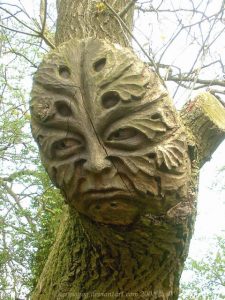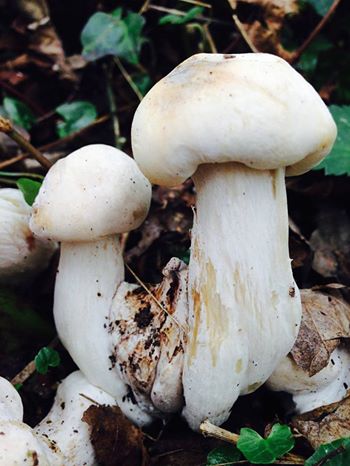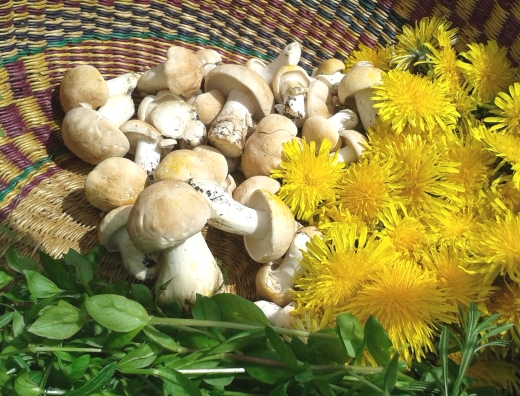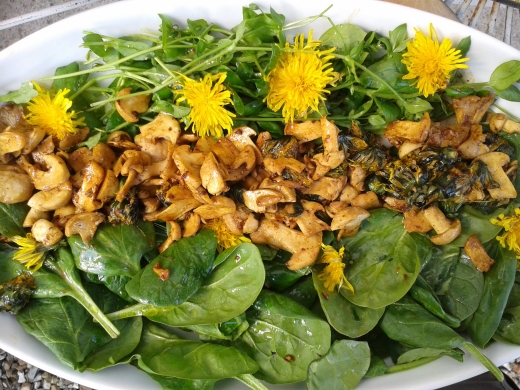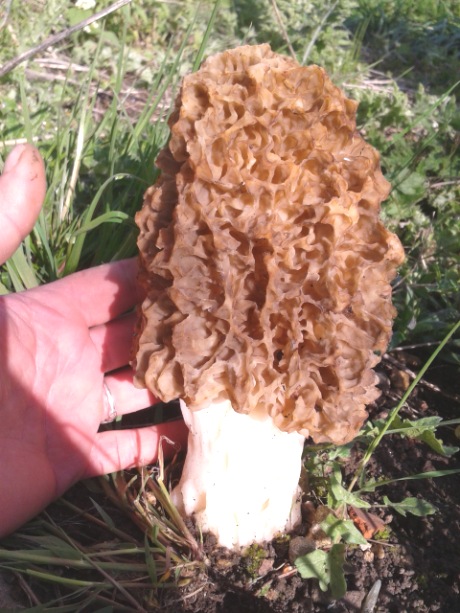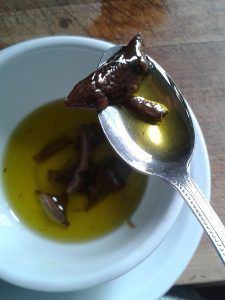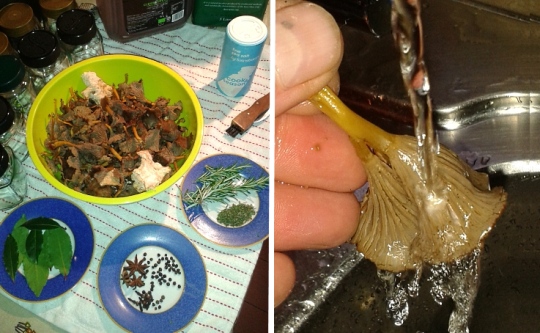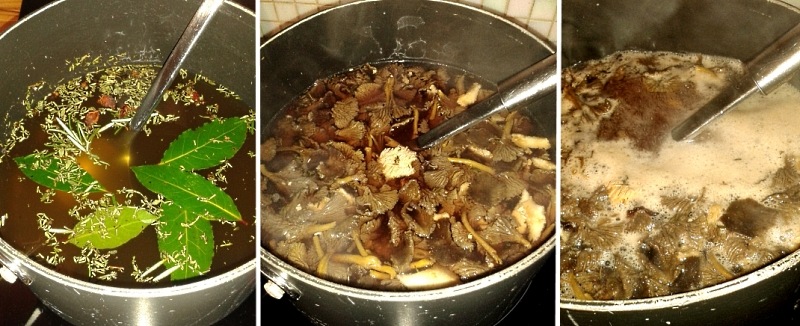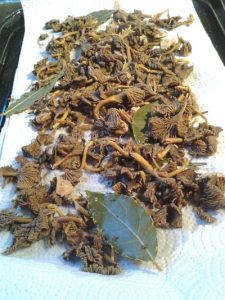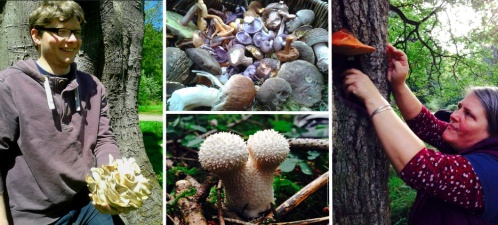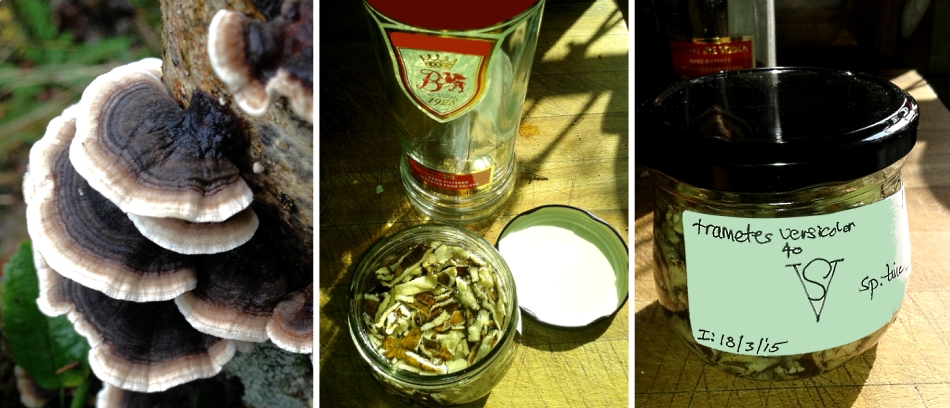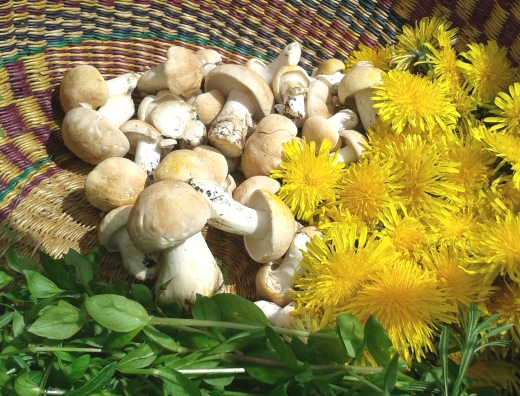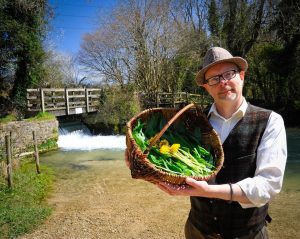Today I awoke to the sight of a magnificent frost covering the Avebury stone circle and a bluer than blue sky heralding a bright (though as it turned out showery) spring day. Needing to re-shuffle the stores in the pantry I noticed there was still a three-quarter full 2 litre jar of dried St. George’s mushrooms left over from last season, so with the new season definitely underway now I decided to get creative with the flavour of these delightful mushrooms by making an antipasti that combines them with wild garlic ‘capers’ and dried elderberries. You can make this antipasti of mushrooms with either fresh or dried St. George’s and incorporate other foraged ingredients to make a flavour combination that is uniquely your own. Using dried mushrooms has the advantage that it can be made from stores whenever a fresh batch is needed. A lot of other mushrooms will preserve well using this method too, but there is only one way to find out which flavours will work together and that is to experiment. Here is my recipe, enjoy!…
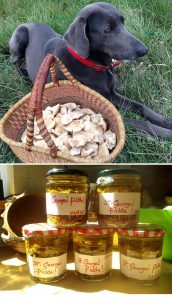
Forager’s St. George’s Mushroom, Wild Garlic and Elderberry Antipasti
Ingredients:
1.5 litres of dried St. George’s Mushrooms (Calocybe gambosa). You can use fresh St. George’s Mushrooms instead if you like, but you will have to experiment with the volume of brine (vinegar/salt/water) to ensure that there is enough for the quantity that you have. The recipe below should work with approximately 1.5kg of fresh St. George’s too.
A small handful of wild garlic flower buds.
A small handful of dried elderberries (optional).
A thinly sliced knob of root ginger.
2 tbsp of sea salt (I used herb salt in mine).
A generous twist of black pepper.
400ml olive oil.
400ml mustard oil (you could substitute sunflower).
800ml organic cider vinegar.
400ml warm water.
(All quantities are approximate)
Step 1: Marinating
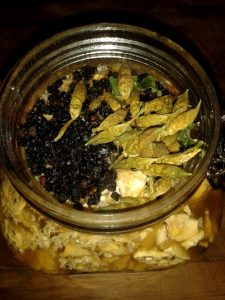 Place the mushrooms, elderberries, ginger, wild garlic buds and black pepper in a large Kilner jar or other similar storage jar. Mix together the warm water, cider vinegar and sea salt until the sea salt is completely dissolved. Pour this liquid brine over the solid ingredients in the storage jar, stir with a wooden spoon and allow the whole to marinade in a warm place for 2 hours.
Place the mushrooms, elderberries, ginger, wild garlic buds and black pepper in a large Kilner jar or other similar storage jar. Mix together the warm water, cider vinegar and sea salt until the sea salt is completely dissolved. Pour this liquid brine over the solid ingredients in the storage jar, stir with a wooden spoon and allow the whole to marinade in a warm place for 2 hours.
Step 2: Brining
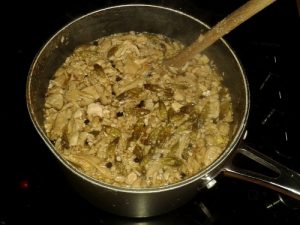
Strain the liquid from the mushrooms in the jar using a colander or sieve and place it in a saucepan. Bring to the boil over a high heat, stirring occasionally. Do not let the liquid boil over. Once you have the brine on a rolling boil, add all of the mushrooms and other solids back into the liquid and bring the mixture back up to the boil, allowing it to boil for 4 minutes. Note: Longer boiling times are required for some other edible mushrooms, particularly those in the Russula (brittle cap) and Lactarius (milk cap) groups, as well as honey fungus (Armillaria mellea). If in doubt please consult a reliable source for information about the mushrooms that you intend to pickle. After 4 minutes remove the saucepan from the heat completely. NOTE: After this point all utensils, bowls and jars that come into contact with the mushrooms MUST be sterilised first (using boiling water is fine).
Step 3: Draining
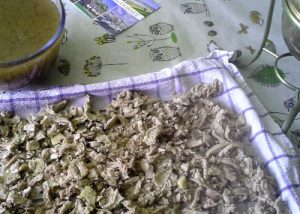
Once again separate the solids from the liquid by straining. You can bottle the brining liquid in a tightly sealed sterilised jar for future use and it ought to be good for at least another couple of brinings. You can always top it up if you start to find you haven’t got enough, so best to keep it for later and avoid wastage.
Spread the solid part, mushrooms, spices and all, onto a clean tea cloth that has been boil washed to remove any traces of taint that may be left behind from washing powder or detergent. Ideally place the dish cloth on an oven tray or similar which will catch any moisture that drips through. Leave the mushrooms to drain for an hour or so, then carefully press out any excess moisture by rolling the solids up in the tea cloth. Do not press too hard or you will ruin their appearance and crush them!
Step 4: Covering in oil
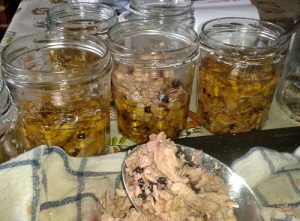
Carefully ladle the dried off mushrooms into the sterilised jars that you have prepared one layer at a time. Cover each layer in your chosen vegetable oil. I have started experimenting with a 60:40 mixture of mustard oil and extra virgin olive oil. So far this seems to be working a treat, imparting a warmness to the pickle as well as improving the colour, without being too thick or having too much flavour. By pouring the oil into the mushrooms in layers and stirring very slowly you will be liberating as many air bubbles as possible from the oil, which will improve the shelf life of your pickle.
Step 5: Labelling
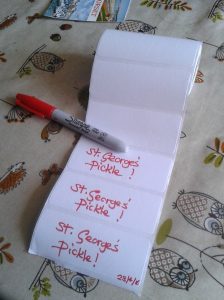 Always remember to label your produce carefully. Everyone must have found an unlabelled jar at the back of the cupboard at some point – with unknown contents that are probably well past their best. Always put the date of manufacture on the label.
Always remember to label your produce carefully. Everyone must have found an unlabelled jar at the back of the cupboard at some point – with unknown contents that are probably well past their best. Always put the date of manufacture on the label.
Your pickled mushrooms will improve in flavour over a month or more. You should aim to start eating them within 2 months and once you have opened a jar keep it in the fridge and consume within a couple of weeks. For this reason it is better to make lots of small jars rather than one big jar full! Unopened jars kept in a cool place should keep for at least 6 months, probably a good bit longer.
Bon appetite! Enjoy with salad leaves, artichoke hearts or ladled onto doorstops of bread!
If you would like to learn how to identify and find the St. George’s mushroom for yourself, the time is now and the season is short! Why not come and join us at The Wild Side of Life in Wiltshire for a day of St. George’s hunting and dining using wild food ingredients, and enjoy your St. George’s mushrooms over a glass or two of champagne. Bring a friend along to enjoy the fun with you and your second ticket will be half price this year . For more information on this special forage and feast (Saturday 7th of May 2016)
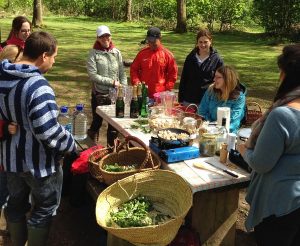
The St. George’s Mushroom Champagne Picnic (7th May 2016)

